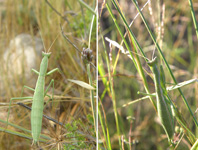Abstract
For many years researchers studying the fauna of the Canary Islands have only sparsely treated the charismatic insect order of praying mantises (Mantodea). By studying the known literature it becomes obvious that there are several inconsistencies regarding mantodean taxonomy as well as the number of actual species and their distribution within the archipelago. In the present contribution, the literature treating the Canary Island Mantodea fauna is thoroughly reviewed, and the distribution of the ten known Mantodea species is presented with additional comments on the taxonomic problems. The taxonomy and distribution of the Canary Island Amelinae has been causing some confusion in the literature and is therefore discussed for a better understanding of the composition of this group. So far, seven species of Amelinae (two species of Ameles Burmeister and five species of Pseudoyersinia Kirby) are recognized for the Canary Islands. A careful survey of the taxonomic literature indicates that there is a substantial degree of variability in this group, which may have led to frequent misidentifications. This is reflected by the inconsistent literature data on the distribution of several Pseudoyersinia species within the archipelago. A crucial amendment and clarification is provided regarding the date of description (1838) of Ameles gracilis (Brullé) and Ameles limbata (Brullé) as it varies in the literature. Nomenclatural changes regarding the homonymy of Mantis limbata Brullé and Mantis limbata Hahn, previously proposed by Koçak & Kemal (2008), are rejected and discussed in detail. One of the Mantodea species, Empusa pennata (Thunberg), is frequently mentioned in the literature to be present on the Canary Islands, but after carefully reviewing the literature data it is evident that this species has never actually been found on any of the islands. The aim of this publication is to lay a basis for future research on the Mantodea fauna of the Canary Islands, their phylogenetic placement and history of dispersal. This is even more important as the archipelago is a European endemism hot spot for praying mantises and these basic parameters are crucial for implementing plans regarding conservation strategies on the islands.

